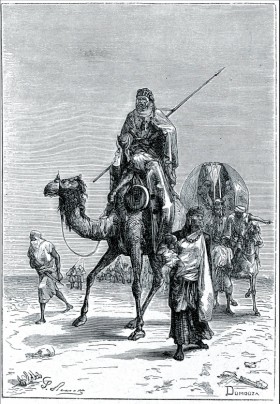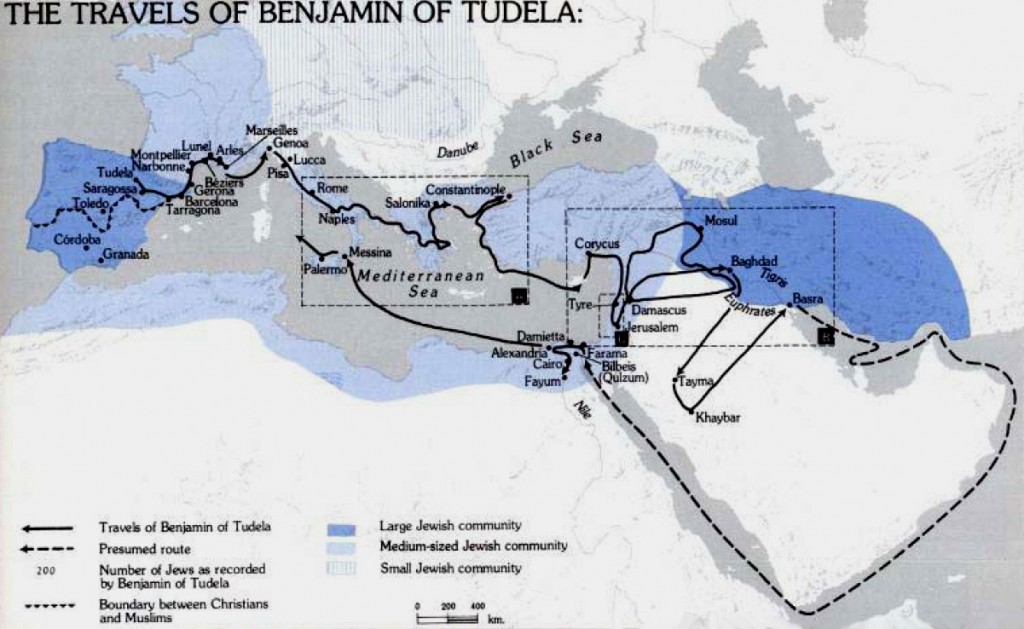Rabbi Benjamin of Tudela (Hebrew: מִטּוּדֶלָה בִּנְיָמִין) (Tudela, Spain, 1130 – 1173) is an essential character in The 13th Tablet. He is quite possibly, with Marco Polo, one of the most famous travellers of the Middle-Ages. He travelled throughout Europe, Africa and Asia. His fascinating account, originally written in Hebrew and later compiled as the Itineraries of Benjamin of Tudela from his jotted notes, is a mixture of geographic, cultural, commercial and ethnographic data.
It is also a treasure of information on medieval Jewry, as he described each Jewish community he encountered in his travels (i.e. local customs, population and leaders). Most Jews in the 12th century were able to travel in Christian as well as Muslim lands by moving from one Jewish community to the next. But few did so as extensively as Rabbi Benjamin. He was a learned man, who spoke many languages and whose intellectual curiosity was seemingly boundless. He was well versed in the history of ancient (and non-Jewish) civilizations and was curious of all the religious faiths of his time (even rather obscure ones).
For a man who travelled so far, and described so many different men of his time, we know virtually nothing of his personal biography besides the fact that he was from Tudela in the Kingdom of Navarre.
EXTRACTS FROM THE ITINERARIES OF RABBI BENJAMIN OF TUDELA
Rome
There are many wonderful structures in the city, different from any others in the world. Including both its inhabited and ruined parts, Rome is about twenty-four miles in circumference. (…) commencing from King Tarquinius down to Nero and Tiberius, who lived at the time of Jesus the Nazarene, ending with Pepin, who freed the land of Sepharad from Islam, and was father of Charlemagne. (…) In the church of St. John in the Lateran there are two bronze columns taken from the Temple, the handiwork of King Solomon, each column being engraved “Solomon the son of David.” The Jews of Rome told me that every year upon the 9th of Ab they found the columns exuding moisture like water. There also is the cave where Titus the son of Vespasianus stored the Temple vessels which he brought from Jerusalem.
Pozzuoli (southern Italy)
A spring issues forth from beneath the ground containing the oil which is called petroleum. People collect it from the surface of the water and use it medicinally. There are also hot-water springs to the number of about twenty, which issue from the ground and are situated near the sea, and every man who has any disease can go and bathe in them and get cured. All the afflicted of Lombardy visit it in the summer-time for that purpose.
Constantinople
The circumference of the city of Constantinople is eighteen miles; half of it is surrounded by the sea, and half by land, and it is situated upon two arms of the sea, one coming from the sea of Russia, and one from the sea of Sepharad. (…) It is a busy city, and merchants come to it from every country by sea or land, and there is none like it in the world except Bagdad, the great city of Islam. In Constantinople is the church of Santa Sophia, and the seat of the Pope of the Greeks, since the Greeks do not obey the Pope of Rome. (…) A quantity of wealth beyond telling is brought hither year by year as tribute from the two islands and the castles and villages which are there.
(…) Close to the walls of the palace is also a place of amusement belonging to the king, which is called the Hippodrome, and every year on the anniversary of the birth of Jesus the king gives a great entertainment there. And in that place men from all the races of the world come before the king and queen with jugglery and without jugglery, and they introduce lions, leopards, bears, and wild asses, and they engage them in combat with one another; and the same thing is done with birds. No entertainment like this is to be found in any other land.
Syria/Lebanon
In the neighbourhood dwells a people called Al-Hashishim. They do not believe in the religion of Islam, but follow one of their own folk, whom they regard as their prophet, and all that he tells them to do they carry out, whether for death or life. They call him the Sheik Al Hashishim, and he is known as their Elder. At his word these mountaineers go out and come in.
(…) Ten miles therefrom a people dwell who are at war with the men of Sidon; they are called Druses, and are pagans. They inhabit the mountains and the clefts of the rocks; they have no king or ruler, but dwell independent in these high places, and their border extends to Mount Hermon, which is a three days’ journey. (…) They say that at the time when the soul leaves the body it passes in the case of a good man into the body of a newborn child, and in the case of a bad man into the body of a dog or an ass. Such are their foolish beliefs.
Israel
From Jerusalem it is two parasangs to Bethlehem, which is called by the Christians Beth-Leon, and close thereto, at a distance of about half a mile, at the parting of the way, is the pillar of Rachel’s grave, which is made up of eleven stones, corresponding with the number of the sons of Jacob. Upon it is a cupola resting on four columns, and all the Jews that pass by carve their names upon the stones of the pillar. At Bethlehem there are two Jewish dyers. It is a land of brooks of water, and contains wells and fountains.
At a distance of six parasangs is St. Abram de Bron, which is Hebron; the old city stood on the mountain, but is now in ruins; and in the valley by the field of Machpelah lies the present city. Here there is the great church called St. Abram, and this was a Jewish place of worship at the time of the Mohammedan rule, but the Gentiles have erected there six tombs, respectively called those of Abraham and Sarah, Isaac and Rebekah, Jacob and Leah. The custodians tell the pilgrims that these are the tombs of the Patriarchs, for which information the pilgrims give them money. If a Jew comes, and gives a special reward, the custodian of the cave opens unto him a gate of iron, which was constructed by our forefathers, and then he is able to descend below by means of steps, holding a lighted candle in his hand. He then reaches a cave, in which nothing is to be found, and a cave beyond, which is likewise empty, but when he reaches the third cave behold there are six sepulchres, those of Abraham, Isaac and Jacob, respectively facing those of Sarah, Rebekah and Leah. And upon the graves are inscriptions cut in stone; upon the grave of Abraham is engraved “This is the grave of Abraham”; upon that of Isaac, “This is the grave of Isaac, the son of Abraham our Father”; upon that of Jacob, “This is the grave of Jacob, the son of Isaac, the son of Abraham our Father”; and upon the others, “This is the grave of Sarah,” “This is the grave of Rebekah,” and “This is the grave of Leah.” A lamp burns day and night upon the graves in the cave.
Iraq
Thence it is two days to Mosul, which is Assur the Great, and here dwell about 7,000 Jews, at their head being R. Zakkai the Nasi of the seed of David, and R. Joseph surnamed Burhan-al-mulk, the astronomer to the King Sin-ed-din, the brother of Nur-ed-din, King of Damascus. Mosul is the frontier town of the land of Persia.
It is a very large and ancient city, situated on the river Hiddekel (Tigris), and is connected with Nineveh by means of a bridge. Nineveh is in ruins, but amid the ruins there are villages and hamlets, and the extent of the city may be determined by the walls, which extend forty parasangs to the city of Irbil. The city of Nineveh is on the river Hiddekel. In the city of Assur (Mosul) is the synagogue of Obadiah, built by Jonah; also the synagogue of Nahum the Elkoshite.
In Bagdad there are twenty-eight Jewish Synagogues, situated either in the city itself or in Al-Karkh on the other side of the Tigris; for the river divides the metropolis into two parts. The great synagogue has columns of marble of various colours overlaid with silver and gold, and on these columns are sentences of the Psalms in golden letters. And in front of the ark are about ten steps of marble. The city of Bagdad is twenty miles in circumference, situated in a land of palms, gardens and plantations, the like of which is not to be found in the whole land of Shinar. People come thither with merchandise from all lands. Wise men live there, philosophers who know all manner of wisdom, and magicians expert in all manner of witchcraft.
(…) Thence it is a day’s journey to Babylon, which is the Babel of old. The ruins thereof are thirty miles in extent. The ruins of the palace of Nebuchadnezzar are still to be seen there, but people are afraid to enter them on account of the serpents and scorpions.
Further East
Thence it is four days’ journey to Tibet, the country in whose forests the musk is found. Thence it takes twenty-eight days to the mountains of Naisabur by the river Gozan. (…) They are in league with the Kofar-al-Turak [Mongols], who worship the wind and live in the wilderness, and who do not eat bread, nor drink wine, but live on raw uncooked meat. They have no noses, and in lieu thereof they have two small holes, through which they breathe. They eat animals both clean and unclean, and they are very friendly towards the Israelites. Fifteen years ago they overran the country of Persia with a large army and took the city of Rayy; they smote it with the edge of the sword, took all the spoil thereof, and returned by way of the wilderness. Such an invasion had not been known in the land of Persia for many years.
For the Full English text: –> Click here For the Full Hebrew/English edition –> Click here
FURTHER READING
J. Shatzmiller, “Jews, Pilgrimage, and the Christian Cult of Saints: Benjamin of Tudela and His Contemporaries”. In Goffart, W. A., Murray, A. C. After Rome’s Fall: Narrators and Sources of Early Medieval History. Toronto: University of Toronto Press, 1998: 337–347.
Benjamin of Tudela, The Itinerary of Benjamin of Tudela (Transl. Marcus Nathan Adler), Dodo Press: 2007.
The travels of Benjamin of Tudela: through three continents in the twelfth century (Transl. Uri Shulevitz, illustr. Uri Shulevitz), Farrar Straus and Giroux: 2005.



